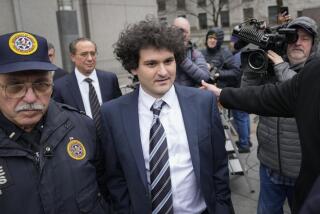There’s No Accounting for Andersen’s Miscalculations
- Share via
As Enron Corp. shareholders and their lawyers circled around accounting firm Arthur Andersen in January, the company offered $750 million to quickly end the civil litigation sprouting from its work as the bankrupt energy trader’s auditor.
The lawyers turned down the deal, hoping for more. They may end up with much less.
That rejection is just one in a series of events that, at nearly every turn, conspired to doom both Andersen and Enron investors, who saw the accounting firm as the best deep-pockets source of restitution for their multibillion-dollar loss in the energy trader’s collapse.
Andersen’s last offer was about $300million, but even William Lerach, the senior class-action attorney in the case, wonders whether it can now come up with that much.
As Andersen’s obstruction-of-justice trial continues this week in U.S District Court in Houston, the firm is splintering, with as many as 100 agreements to sell its various office and practices groups. But it’s not clear whether the deals will provide funds to settle Enron-related claims.
Indeed, shareholders, creditors and other parties have gone to court, variously seeking to block the deals or at least force Andersen to provide more financial details about the transactions. These groups hope to tap any money Andersen collects.
Clients are fleeing. Just the value of the business that has left Andersen, if it had been packaged and sold, might have brought $500 million to $1 billion to fund a settlement, estimated Allan Koltin, a Chicago-based accounting industry consultant who has worked as an advisor to Andersen partners and potential suitors.
Defections since Enron’s bankruptcy filing in December have cost Andersen more than $835 million in revenue, according to a tally of public accounting fee records and other documents by the Los Angeles Times. That measure tracks only lost fees from publicly traded companies. Combined with the desertion of dozens of private company clients, Andersen has lost close to $1 billion of business to rival firms, according to accounting industry experts.
“That’s business the other firms got for free without paying a single penny to the government to cover any fines or to help Enron shareholders,” Koltin said. “I don’t understand why something wasn’t done months ago. Everyone knew how many clients were going to leave.”
Andersen officials declined to comment, but attorneys, former government regulators and Andersen partners who have watched the debacle unfold outlined a series of missteps:
* Andersen executives didn’t recognize the precariousness of the firm’s position quickly enough. Then, as the partnership’s leaders learned of document destruction and other actions that placed the firm in jeopardy, they were unable to devise an effective crisis management strategy.
* Attorneys in the class-action suits didn’t anticipate that Andersen’s business would vaporize so quickly, diminishing their ability to collect a large settlement.
*
The government didn’t heed warnings that a criminal obstruction-of-justice indictment of the firm--rather than individuals--for destroying documents sought in the federal investigation of Enron’s accounting probably would destroy Andersen. The firm’s partners believe Justice Department lawyers were egged on by the Bush administration, which was fearful of charges of favoritism because of its close ties to Enron.
*
Litigation Hampers Firm’s Dismantling
The result is turning out to be what proponents of accounting industry reform feared; with the collapse of Andersen, the industry will be concentrated in the hands of four powerful firms.
“There’s been a perfect storm of elements whipping things around,” said Alan Schulman, a veteran class-action securities litigator. “We have all of these forces at work and no one making good decisions.”
It’s no longer clear whether Andersen will survive long enough for an agreement to be reached. Talks over Andersen’s most recent $300-million settlement offer broke up two weeks ago because of squabbling between Enron creditors and shareholders over how to divide the money.
At best, Andersen will emerge from this scandal as a small firm with a fraction of the staff and the $4.3 billion in U.S. revenue it had six months ago.
“I have a hard time seeing much left of Andersen six months from now,” said a senior partner in the firm, who declined to be identified because he feared government reprisal. “The Department of Justice put us out of business.”
Andersen’s ability to dismantle itself in an orderly fashion is hampered by its civil and criminal litigation.
For example, in announcing Wednesday a $284-million deal to acquire 23 independent Andersen consulting units, KPMG Consulting Inc. said the agreement “is subject to the satisfactory resolution of potential liability issues.”
As each day passes without resolution of the civil and criminal cases, Andersen’s rivals get for free what they otherwise would have had to buy. Ernst & Young, the nation’s third-largest accounting firm, appears to be the early winner, picking up 89 clients and $205million of former Andersen work. Each of the three other players, which with Andersen and Ernst & Young made up the industry’s Big Five firms, have won client billings of more than $140 million.
At the outset of the Enron crisis, members of the class-action bar recognized that they shared an interest with Andersen’s partners in seeing the firm survive. A viable Andersen represented the Enron shareholders’ best source of recovery.
Such a goal was the center of early settlement talks, the senior partner said.
“Under the settlement that was on the table, we would have devoted a significant portion of our salaries to pay Enron shareholders over a 10-year period,” he said.
The plan was rejected by the class-action attorneys, who were looking to get more money from the firm.
The senior Andersen partner said the firm’s willingness to encumber its profit for such a long period was an example of how it planned to accept responsibility for the Enron mess. But others say Andersen acted too slowly to save itself.
As the Enron crisis broke, Andersen’s senior leadership began to act out an organizational death wish, said Richard C. Breeden, former chairman of the Securities and Exchange Commission.
One glaring failure was not assessing the damage to its relationship with federal regulators resulting from a series of recent problems with other clients, he said. Barely six months earlier, Andersen paid the SEC a $7-million fine--the largest for an accounting firm--to settle allegations that it issued false and misleading reports in its audit of Waste Management Inc. A year earlier, Andersen paid Sunbeam Corp. shareholders $110 million to settle a fraud lawsuit.
Having acknowledged that staff destroyed thousands of documents at multiple offices sought in the federal probe, and already facing SEC sanction, there’s only one rational strategy, said Breeden: Tell the truth, fire top management and everyone involved with Enron and beg the government for mercy in the interest of causing the least disruption to the nation’s financial reporting system.
“The most inexplicable thing in all of this is why Andersen did not immediately accept responsibility and settle quickly,” Breeden said. “I think it is an example of the lawyers taking control of how Andersen should respond instead of the business people.
“Early on, the line out of Andersen should have recognized its failure and conceded that it would have to pay its share of damages,” Breeden said.
*
Tactical Errors Made in Client Relations
That was Andersen’s plan, the senior partner said, but it was tripped up by the aggressive stance of the Justice Department. Other Andersen executives, including managing partner Larry Gorrell and former Chief Executive Joseph F. Berardino, did not return calls seeking comment for this report.
Berardino told Congress in December that the accounting firm was in effect hoodwinked by Enron. A month later, Andersen admitted that its staff destroyed Enron documents. It then blamed the action on a rogue employee, David B. Duncan, the senior Houston partner on the Enron account, when other evidence pointed to an institutional effort across several offices. Duncan admitted guilt in a plea agreement and looks to be a star witness as the Justice Department goes after the accounting firm and Enron’s senior executives.
“Andersen forced the Justice Department to indict it by being arrogant and denying something everybody else knew,” Breeden said. “You can’t destroy evidence and obstruct justice. We forced President Nixon from office for no less.”
Just as Andersen misjudged the federal prosecutors, it also made a series of tactical errors in its client relations.
A letter from Andersen’s attorney to the Justice Department was leaked in March, just a day before the indictment was unsealed. The letter said that such an indictment “would place the survival of Arthur Andersen LLP in grave jeopardy.”
The unintended consequence of that statement, Breeden said, was to force clients to find new auditors. No responsible board member at an Andersen client would stick with a firm that by its own estimate probably would go out of business, he said.
The timing of the indictment and the leaking of the letter, at the start of the period when companies pick their auditors for the coming year, compounded Andersen’s problems.
Before the indictment, Andersen attempted to appease its critics and reassure clients by asking Paul A. Volcker, the well-respected former Federal Reserve Board chairman, to head an independent oversight board that it claimed had the power to make sweeping changes in leadership and policies. Volcker offered to take control of the firm after the indictment.
But this initiative also misfired. Volcker waited for Andersen to give clear signals that its partnership was agreeable to massive changes in its policies and structures. He also expected Andersen to work more quickly to settle the criminal and civil litigation it faced.
*
Indictment Considered the Turning Point
Instead of supporting Volcker, Andersen’s partners stepped up negotiations to move their business to rival firms. Most of the 1,700 partners were more concerned about an exit strategy than creating a new firm under Volcker that would shed consulting and much of its tax practice to focus on auditing, said Koltin, the industry consultant.
Though Berardino resigned, Volcker, 74, did not move forcefully to take control of Andersen and dictate changes, instead insisting on measures such as suspension of the indictment and progress toward a settlement of the civil litigation before he would step in.
“In a survival situation the person who is brought in to solve the problem has to be able to plunge themselves in full time,” Breeden said. “This can’t be done from an advisory board.”
The Justice Department also was culpable in the firm’s rapid erosion, said Randolph Beatty, dean of the USC school of accounting. Beatty said prosecutors should have understood how their actions would endanger Andersen’s ability to survive. Instead of indicting the institution, they should have gone after the individuals who were involved in the document destruction, he said. Duncan is the only individual associated with Andersen to be charged in the case.
Andersen and its legal team believed the Justice Department would not indict the firm, in part because Andersen had told prosecutors about the document destruction. According to attorneys involved in similar litigation, companies that voluntarily report wrongdoing typically win some leniency.
Andersen partners who talked to The Times for this report remain angry about how the Justice Department treated the firm. Moreover, the Justice Department appears to have gyrated widely in its dealings with Andersen. According to the March 13 letter from Andersen attorneys seeking to persuade the government not to indict the firm, the Justice Department essentially gave Andersen an ultimatum: Plead guilty by 9 a.m. March 14 or face indictment.
It rejected an Andersen proposal to defer prosecution in return for firing individuals responsible for the document destruction and agreeing to a special monitor to oversee reforms.
A few weeks later, after the indictment was unsealed, the government resumed negotiations with Andersen over a deferred prosecution deal, but ultimately aborted talks and decided to go to trial.
Most involved in Andersen’s survival efforts agree that the indictment was the turning point.
“I think Andersen would have done fine financially if it were not for the indictment,” class-action attorney Lerach said. “Sure, there would have been some harm to its reputation and lost business, but nothing approaching what has occurred.”
*
Enron Shareholders Looking for Restitution
Lerach, who once hoped to collect more than $1 billion from Andersen, according to people familiar with the case, said the question of whether litigants should have accepted Andersen’s $750-million settlement offer is irrelevant. The accounting firm’s deteriorating financial condition would have prevented it from making the payments even if Lerach had agreed.
In recent settlement talks, Enron’s creditors--primarily its bankers--wanted as much as half of the money Andersen offered. That irked attorneys for the shareholders, who named many of the same banks as defendants in the class-action lawsuit, alleging that they were culpable in the aggressive financial maneuvers that led to the energy trader’s bankruptcy.
“This was a hideously complicated situation in which people were trying to settle complex claims on a very tight time frame,” Lerach said.
Though efforts to settle with Andersen may resume, for now shareholders are looking elsewhere, including to Wall Street banks that did work for Enron, for restitution.
“There are just too many competing interests, too many uncertainties and insufficient resources to make it all work,” Lerach said.
More to Read
Inside the business of entertainment
The Wide Shot brings you news, analysis and insights on everything from streaming wars to production — and what it all means for the future.
You may occasionally receive promotional content from the Los Angeles Times.











